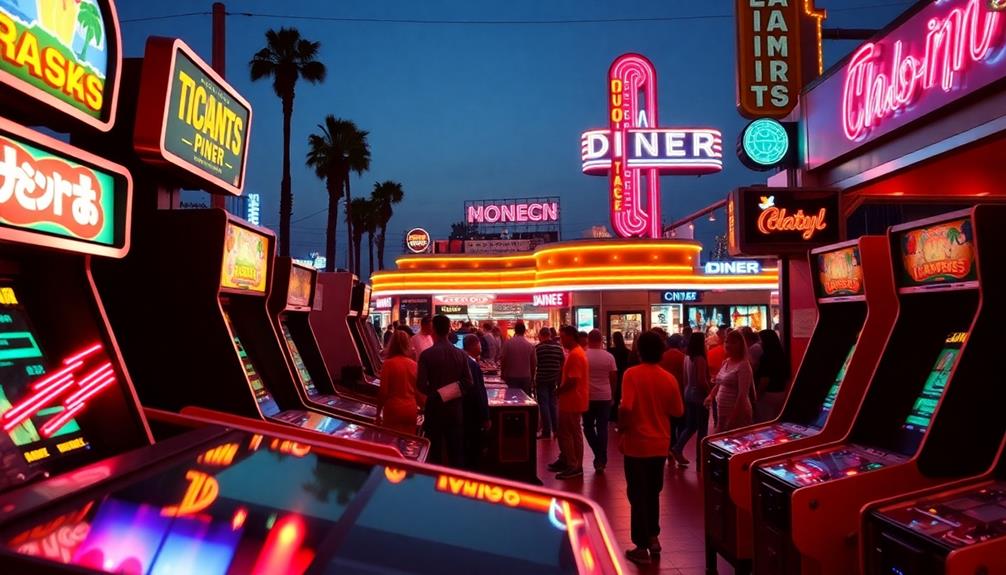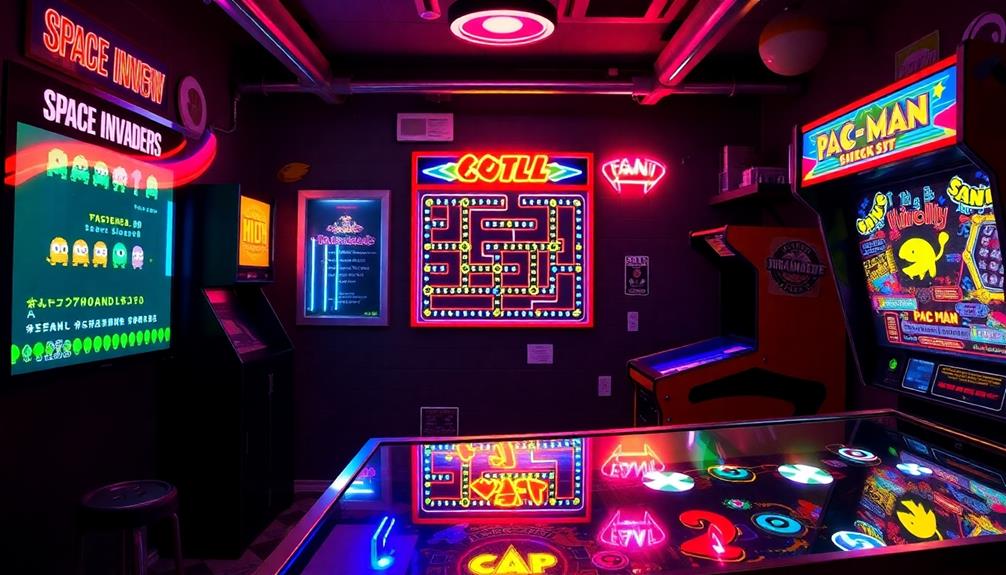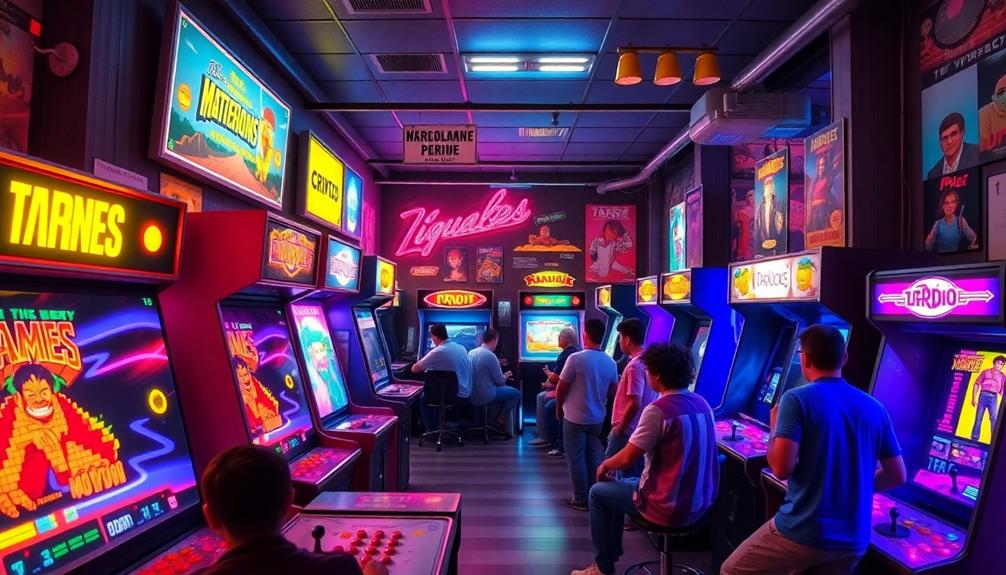The United States is the birthplace of arcade games, with the pioneering game Skee-Ball debuting in 1908. This momentous occasion marked the start of a new era of entertainment. In 1931, the first successful pinball machine, Baffle Ball, was introduced. Fast forward to 1971, when Nolan Bushnell and Ted Dabney revolutionized the gaming industry with Computer Space, the first arcade video game. This groundbreaking innovation is said to have launched the Golden Age of Arcades, with iconic titles like Pong and Pac-Man shaping gaming culture. These early advancements ignited a worldwide fascination with arcade gaming. If you’re interested in learning more about the evolution and success of this gaming culture, there is plenty to explore.
Key Takeaways
- The first coin-operated arcade game, Skee-Ball, was introduced in the United States in 1908.
- Baffle Ball, the first successful pinball machine, was launched in 1931 in the U.S.
- Computer Space, the first arcade video game, was developed in the U.S. by Nolan Bushnell in 1971.
- Atari, founded by Bushnell in California, became a pivotal force in arcade game development post-1972.
- Japan's arcade culture was significantly shaped by the release of Space Invaders in 1978, leading to a booming market.
Origins of Coin-Operated Games
Coin-operated games have a rich history that dates back over a century, with Skee-Ball leading the charge in 1908 as one of the earliest forms of arcade entertainment. In the early 20th century, these games became popular, providing affordable fun during tough times.
The first commercially successful pinball machine, Baffle Ball, debuted in 1931, revolutionizing the landscape of coin-operated games and paving the way for future innovations. This innovation and the emergence of best rated pinball machines of 2024 demonstrate the enduring appeal of pinball across generations.
As the years progressed, David Gottlieb introduced one of the first successful pinball machines, which thrived during the Great Depression, proving that people craved entertainment that didn't break the bank.
Fast forward to 1971, when the first arcade video game, Computer Space, hit the scene, marking a pivotal moment in the video game industry. This innovation led to the launch of the Magnavox Odyssey in 1972, the first home video game system, which featured a simple ping pong game, showcasing a new direction in gaming.
These milestones in the evolution of arcade entertainment laid the groundwork for the vibrant gaming culture we see today. You can appreciate how these early innovations shaped the future of gaming, both in arcades and at home.
The Birth of Video Arcade Games
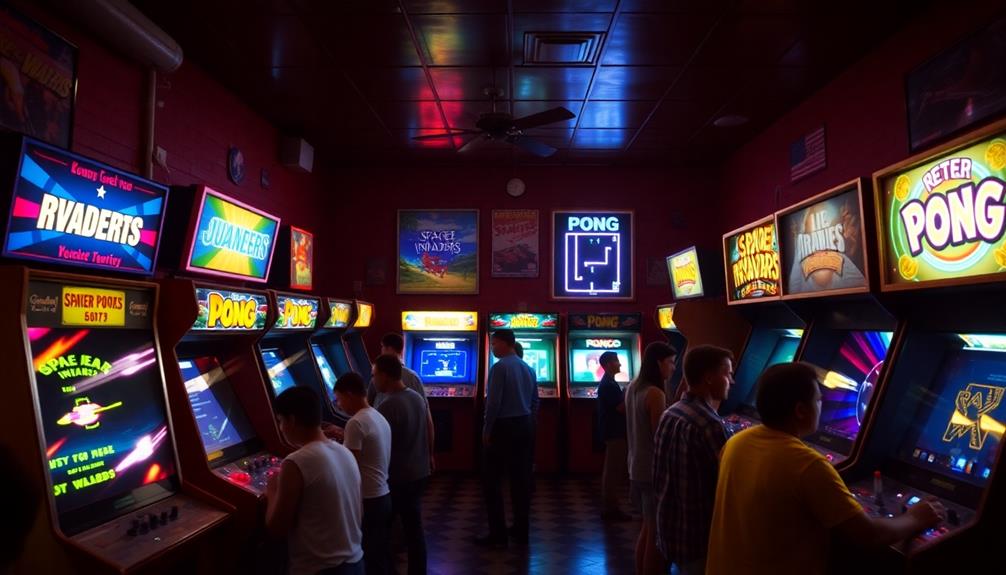
The birth of video arcade games marks a revolutionary shift in the gaming landscape, setting the stage for the vibrant culture we enjoy today. In 1971, Nolan Bushnell and Ted Dabney introduced the first arcade game, Computer Space, through Nutting Associates. This pioneering title, inspired by Spacewar!, involved flying a rocket and battling saucers, but faced marketing hurdles due to its complexity.
Following their departure from Nutting Associates, Bushnell and Dabney founded Atari and launched Pong in 1972. This game became the first commercially successful arcade video game, igniting the arcade gaming phenomenon.
The table below showcases significant milestones in the early arcade gaming era:
| Year | Game Title |
|---|---|
| 1971 | Computer Space |
| 1972 | Pong |
| 1978 | Space Invaders |
| 1980 | Pac-Man |
The Golden Age of Arcades

During the Golden Age of Arcades, you witnessed the rise of iconic games like Pac-Man and Donkey Kong that transformed the gaming landscape.
This era not only shaped pop culture but also sparked fierce competition, setting the stage for modern esports.
Importantly, the influence of celebrity culture on gaming trends can be seen through the popularity of games among stars, such as the outrageous antics of Natalie Nunn that often paralleled gaming themes.
As you explore this vibrant period, you'll see how these games and tournaments left a lasting legacy in the world of entertainment.
Iconic Games of Era
From 1978 to 1983, arcade gaming transformed into a cultural phenomenon, giving rise to several iconic titles that shaped the industry.
Space Invaders, released in 1978, ignited a gaming revolution, selling over 100,000 machines in Japan within its first year. It enchanted players with its simple yet addictive gameplay, much like how early pinball machines laid the groundwork for future gaming innovations.
In 1980, Pac-Man further solidified the Golden Age of Arcades, becoming the best-selling arcade game with around 400,000 cabinets sold by 1982. Its colorful, maze-chasing action appealed to a diverse audience, transcending typical gamer demographics.
Donkey Kong, introduced in 1981, was another groundbreaking title that pioneered the platformer genre while incorporating a mesmerizing storyline. This marked a significant shift in arcade narratives, making gameplay more engaging.
Meanwhile, Asteroids, released in 1979, emerged as one of the highest-grossing games of its time, bolstering the arcade industry's revenue.
The rise of video game tournaments during this era, fueled by games like Pac-Man and Donkey Kong, laid the groundwork for modern esports and competitive gaming culture.
Together, these iconic games defined a transformative period in arcade history, forever altering the landscape of gaming.
Cultural Impact and Legacy
Arcade gaming burst into mainstream culture in the late 1970s and early 1980s, leaving an indelible mark on entertainment and social interaction. The Golden Age of Arcades saw the rise of iconic titles like Space Invaders and Pac-Man, which shaped the cultural significance of arcade games.
Astrology and Attractiveness suggest that different genres of games appeal to varied personality traits, much like how zodiac signs influence perceived beauty. Space Invaders' immense popularity even caused a coin shortage in Japan, leading to over 100,000 machines sold within a year.
Meanwhile, Pac-Man introduced a non-violent mascot character, becoming the best-selling video game with around 400,000 arcade cabinets sold by 1982.
This era didn't just change gaming; it transformed entertainment culture as a whole. By January 1982, the U.S. boasted over 13,000 arcades, with popular machines raking in over $400 daily.
The rise of arcade gaming also laid the groundwork for video game tournaments in the 1980s, igniting a competitive spirit that would evolve into today's esports industry.
The legacy of the Golden Age of Arcades is still felt, as these classic games continue to inspire new generations, reminding you of the vibrant community and excitement that defined an era in gaming history.
Arcade Competition Dynamics
The vibrant community fostered by the Golden Age of Arcades also sparked fierce competition among players and arcade owners alike. As iconic games like Space Invaders and Pac-Man gained traction, arcade popularity soared, but so did the stakes.
You'd find yourself drawn into the thrill of arcade competition, where high scores became the ultimate goal, driving you to refine your skills. This competitive atmosphere mirrors the importance of setting specific targets, much like establishing savings goals, as players aimed to achieve personal bests and secure their place in arcade history.
Key dynamics shaped this competitive landscape:
- Interactive audio enhanced player immersion, making each victory feel monumental.
- Tournaments tracked by Twin Galaxies laid the groundwork for competitive gaming and modern esports.
- The influx of over 13,000 arcades by 1982 created a battleground for revenue, making every quarter count.
- Market saturation caused revenue to plummet, dropping from $8.9 billion in 1982 to $4.5 billion in 1984.
- The emergence of persistent high scores pushed players to excel and claim their legacy.
In this dynamic environment, the thrill of competition not only defined the arcade experience but also set the stage for the future of gaming, leaving an indelible mark on popular culture.
Regional Variations in Arcade Culture

Different regions around the world have shaped their unique arcade cultures, reflecting local gaming preferences and societal influences. In the United States, the first commercial arcade game, Computer Space, paved the way in the early 20th century. However, Japan took a different route, with Space Invaders launching in 1978 and becoming a massive hit. By 2009, Japan's arcade revenue soared to around $6 billion, while Western arcades struggled against home consoles.
The cultural significance and structure of arcades vary widely. Here's a quick comparison:
| Region | Arcade Focus | Popular Games |
|---|---|---|
| Japan | Classic & Modern Gaming | Space Invaders, Tekken |
| Western Arcades | Family Entertainment Centers | Dance Dance Revolution |
| Competitive Gaming | Major Tournaments in Japan | Street Fighter, Mario Kart |
| Declining Markets | Shift towards home consoles | – |
While Western arcades evolved into Family Entertainment Centers, Japan's arcades remained dedicated to immersive gaming experiences, fostering a vibrant competitive scene. The regional variations in arcade culture illustrate the diverse ways people engage with arcade games.
Technological Advancements in Arcades
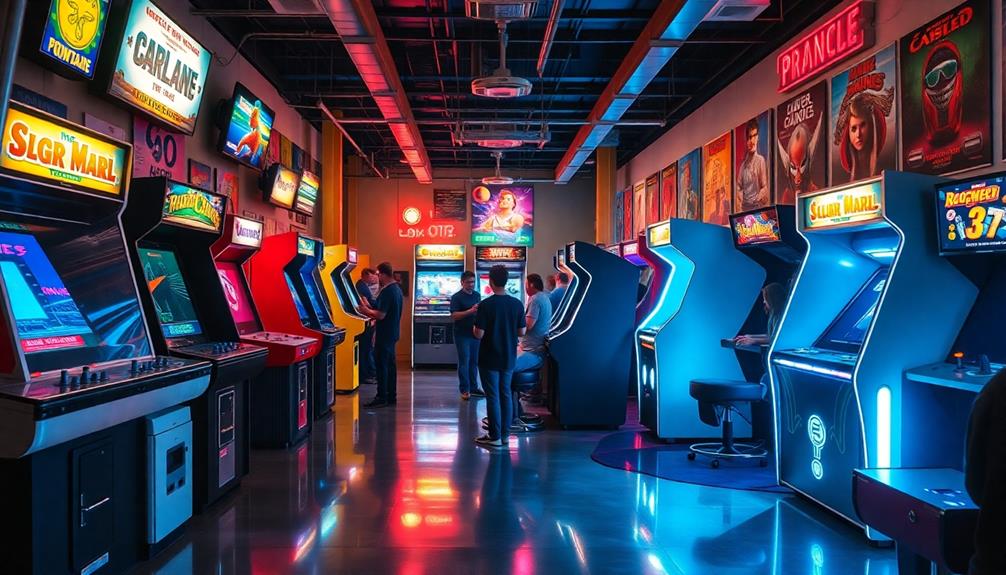
You might be surprised to see how far arcade technology has come since the days of electro-mechanical games. The evolution of 3D graphics transformed the gaming experience, making it more immersive and visually appealing, while the introduction of soundtracks, such as those found in uplifting music like Blue Skies and Lemonade, enhanced player engagement.
Regional market differences shaped the types of games players encountered. Let's explore how these advancements changed the arcade landscape and kept players coming back for more.
3D Graphics Evolution
Transforming the landscape of arcade gaming, the shift from 2D to real-time 3D polygon graphics in the early 1990s marked a pivotal moment in the industry.
With advancements like Sega's Model 1 leading the charge, you witnessed a technological renaissance that reshaped the way you played arcade games. This evolution mirrored the advancements seen in the home entertainment sector, where top projectors for gaming enthusiasts began to enhance the gaming experience with high refresh rates and low input lag.
This graphics evolution introduced groundbreaking features, including:
- 3D polygon graphics that created a more immersive experience.
- Texture mapping and shading techniques enhancing visual fidelity.
- Iconic games like Virtua Racing and Virtua Fighter showcasing new capabilities.
- Motion simulation and virtual reality games that elevated engagement.
- Advanced arcade hardware that consistently outperformed home consoles.
As you played these revolutionary titles, you could sense the excitement in the air. The vibrant colors and dynamic environments drew you in, making it hard to leave the arcade.
By the late 1990s, the gap between arcade and home gaming systems highlighted the innovation and dedication of the arcade industry. With each new game, you experienced not just entertainment but a glimpse into the future of gaming.
This shift set the stage for an era that would continue to captivate players for years to come.
Electro-Mechanical Game Innovation
As the 1960s unfolded, the introduction of electro-mechanical (EM) games revolutionized the arcade landscape, blending electronic and mechanical components to create an engaging gaming experience. One of the first EM games, Sega's Periscope, released in 1966, marked a significant technological advancement in arcade gaming.
These games emphasized skill, reshaping public perception and acceptance of coin-operated machines during this era. The innovation in gameplay mechanics was akin to the advancements in AI-powered virtual reality in e-learning, which similarly enhances user engagement through immersive experiences.
With innovative features like moving parts and interactive audio systems, EM games captivated players, paving the way for the eventual shift to video games. The surge in popularity of EM games, alongside pinball machines, not only enhanced gameplay but also contributed to the establishment of arcade culture.
This cultural shift laid the groundwork for more complex game cabinets, which would eventually lead to the digital gaming revolution of the 1970s. You can see how these early electro-mechanical games set the stage for the vibrant arcade scene we understand today.
Their influence persists in modern gaming, reminding us of the foundational role they played in shaping the entertainment landscape.
Regional Market Differences
In exploring regional market differences, it's clear that technological advancements in arcades have shaped gaming experiences uniquely across the globe. The arcade gaming industry began in the US with the launch of Computer Space, but Japan quickly emerged as a powerhouse.
By the late 1970s, Taito's Space Invaders sold over 100,000 arcade machines in Japan, deeply embedding itself in arcade culture. Remarkably, the integration of modern technology has led to an evolution in arcade machines, allowing for features that enhance gameplay enjoyment, similar to best arcade machines for home game rooms.
Key differences include:
- Japan's thriving arcade market, which generated $6 billion by 2009.
- Sega's dominance, capturing 60% market share in the arcade sector by 2006.
- The introduction of 3D graphics in the early 1990s, revolutionizing gameplay.
- A decline in home video game sales in Japan, contrasting with trends in the US arcade industry.
- Regional differences in arcade popularity, with Japan maintaining robust arcade venues while the West shifted toward home entertainment.
These advancements highlight how technology influences regional preferences. While the US arcade industry saw a downturn, Japan continued to embrace arcade culture, showcasing the impact of technological evolution on gaming experiences worldwide.
The Future of Arcade Gaming

The future of arcade gaming holds both challenges and opportunities as the industry evolves. With over 8,000 arcade closures in the past decade, traditional arcade formats face a tough road ahead.
However, nostalgia for classic arcade experiences fuels a resurgence of early games on mobile platforms, with titles like Pac-Man racking up millions of downloads. This shift highlights changing player preferences, as many find joy in revisiting these retro games. To navigate this digital transformation, arcade owners could benefit from strategies that encourage a balance between technology use and creative expression, which emphasizes nurturing an imaginative mindset.
Moreover, redemption games, such as claw machines, have gained popularity, often surpassing traditional video games in appeal.
Yet, competitive gaming events and tournaments breathe new life into arcade-style play, fostering a vibrant community around these experiences. Manufacturers like Raw Thrills and LAI Games are responding to this demand by developing modern titles that blend classic gameplay with innovative technology, ensuring that the essence of arcade gaming remains intact.
As the landscape continues to shift, you'll likely see a mix of old and new, where classic experiences coexist with fresh, engaging content.
Embracing this duality could be key to revitalizing the arcade scene and ensuring its future success.
Frequently Asked Questions
Where Did Arcade Games Come From?
Arcade games originated in the early 20th century, evolving from coin-operated machines like Skee-Ball and pinball. By the 1970s, video games gained popularity, transforming entertainment with iconic titles that captivated audiences everywhere. The history of arcade games is marked by the rise of game cabinets and the introduction of classic titles like Pac-Man and Space Invaders. These games became synonymous with the arcade experience, drawing in players of all ages and creating a unique gaming culture. Today, the history of arcade games continues to influence modern gaming, with many classic titles being reimagined and revived for new audiences. The appeal of arcade games lies in their fast-paced, competitive nature and the social aspect of playing in public spaces. The thrill of trying to beat high scores and the sense of accomplishment when succeeding keeps players coming back for more. Additionally, the nostalgic factor of arcade games, along with their simple yet addictive gameplay, is why arcade games are popular among both seasoned gamers and newcomers alike.
What Was the Very First Arcade Game?
The very first arcade game you'd encounter is Computer Space, released in 1971. It's a challenging game where you pilot a rocket, battling flying saucers, laying the groundwork for future arcade innovations.
What Was the First Arcade Company?
The first arcade company you should know about is Atari. Founded in 1972 by Nolan Bushnell and Ted Dabney, they revolutionized gaming with their innovative designs, especially with the iconic game Pong that followed shortly after.
Which Came First, Donkey Kong or Pacman?
If you're wondering which game came first, Pac-Man was released in 1980, while Donkey Kong followed in 1981. Both games shaped arcade history, but Pac-Man had the earlier debut that captivated players worldwide.
Conclusion
As you step into a vibrant arcade, the sounds of beeping machines and cheering players envelop you like a warm embrace. From the humble beginnings of coin-operated games to today's dazzling digital experiences, arcade culture has evolved into a colorful tapestry of nostalgia and innovation. You can almost feel the electric buzz of competition and camaraderie in the air. The future of arcade gaming beckons, promising even more thrilling adventures waiting just around the corner.
